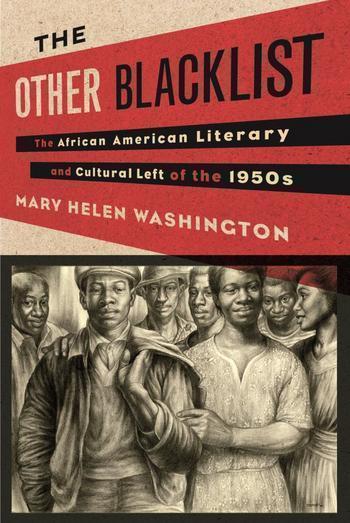
The McCarthy era ‘Red Scare’ and blacklist was undoubtedly an assault on the Communist Party, as well as the broader labor-led left. While individual Party leaders, members and close allies bore the brunt of the assault on democratic rights, other forces close to the left (communist or otherwise) were also affected by the wave of repression.
Mary Helen Washington’s The Other Blacklist: The African American Literary and Cultural Left of the 1950s is a welcomed addition to the history of this period, especially its impact on African Americans.
To her credit, Washington doesn’t gloss over the role of the Communist Party in fostering, facilitating and supporting a Black ‘Popular Front’ of literary and cultural figures. She writes, “…it is clear why the CP attracted blacks, especially during the depression.” For, it was the Party’s leadership in the Unemployed Councils, the National Negro Congress, the Sharecroppers’ Union, the Civil Rights Congress and the Council on African Affairs, among other formations fighting for equality, that lead thousands of African Americans to join the Communist Party, and form a Red-Black alliance – even during the 1950’s McCarthy period.
The Other Blacklist starts with an analysis of Lloyd L. Brown, a public CP member, author and editor of the Marxist, Party-led cultural journal Masses & Mainstream. Brown, the author of the classic novel Iron City and essay “Which Way for the Negro Writer,” was constantly hounded and harassed by the FBI.
Iron City found its genesis in real life, as a reflection on Brown’s years as a union organizer in Pittsburgh, his seven month incarceration “for trying to get communists on the ballot,” and his befriending of a young Black man on death row – whom he formed a defense committee with.
According to Washington, “Brown clearly wanted Iron City to represent both the Party’s power as well as the anticommunist attack…” In many regards, Brown novel was an autobiographical socialist-realist novel. It was sold through the Masses & Mainstream subscription list, an illustration of the lefts’ independent cultural apparatus that was soon to be decimated by the ‘Red Scare.’
Brown joined the Party in the early 1930’s through the John Reed Clubs, became active in the Young Communist League, worked to free the ‘Scottsboro Nine,’ eventually becoming a Party leader, literary and cultural figure, and editor of Masses & Mainstream. He eventually left the Party in the late 1950’s – though he remained committed to socialism. Ultimately, Iron City, though largely neglected when first written due to the other blacklist, has now become a central document in postwar Black cultural studies.
The Other Blacklist doesn’t only focus on open Party members. It also highlights the cultural contributions of people like Alice Childress, whose membership in the Party is contested.
Childress, taught dramatic art at the Party-led Jefferson School for Social Sciences, wrote for Party-led publications like Masses & Mainstream, the Daily Worker and Freedom – Paul Robeson’s publication – spoke at Party-sponsored union and May Day benefit events, and worked in the Committee for the Negro in the Arts, among other groups considered treasonous.
Childress was identified by the FBI as a member of the “Harlem Regional Committee” of the Party. However, Brown – an open communist – claimed that Childress “deliberately refused” to join the CP “so as not to handicap herself as a writer and as an actor…” Brown would add, “She was with us on all important issues,” regardless of her actual membership status.
Though her Party membership is contested, through her work in the Harlem Unity Theatre, Committee for the Negro in the Arts, and the interracial New Playwrights theatre – founded by communists Mike Gold and John Howard Lawson – Childress’s “racialized radicalism” undoubtedly became part and parcel of the history of the communist-led radical leftist cultural tradition. And it builds upon a narrative that challenges the standard Cold War view that the Communist Party became irrelevant and isolated after the witch-hunts – and practically had no impact on the late 1950’s early 1960’s era civil rights movements.
This is probably Washington’s greatest contribution in The Other Blacklist – the challenging of this standard Cold War narrative, as, understandably, many communists, leftists and radicals of all stripes, were reluctant to reveal their membership in and participation with progressive forces.
During the height of the ‘Red Scare,’ Childress also risked her livelihood and aided Party members in their underground work. She “crossed the line into subversive and illegal activity” by hosting well-known Party historian Herbert Aptheker, among others, for underground meetings – which “could have meant a jail term for Childress.” Childress’s relationship with the then CPUSA national women’s commission chair, Claudia Jones, is also obscured by the history of McCarthyism and the sanitizing of African American literary and cultural history.
Among other things, Washington contextualizes Childress’s plays “Gold Through the Trees,” “Trouble in Mind,” as well as her essay “For a Strong Negro People’s Theatre,” as part of a radical, working class tradition expanded to include race, gender and sexuality.
Washington also looks at the life and work of artist Charles White, authors Frank London Brown and Gwendolyn Brooks, as well as an analysis of the First Conference of Negro Writers in spring 1959, which – we find out – was funded by CIA front groups and actively worked to obscure, discredit and marginalize then African American communist literary and cultural figures like Lorraine Hansberry and Julian Mayfield.
The Other Blacklist is a well-researched, informative, illuminating work. It succeeds in placing communists, and their allies, in the heart of the African American literary and cultural upsurge that ultimately aided in the emergence of the 1960’s era civil rights movement. By challenging the standard Cold War narrative of Communist Party irrelevance and isolation, The Other Blacklist not only promotes radical African American cultural production in the 1950’s, it also highlights the very real internal and external pressures faced by communists and their allies. It adds nuance and depth, personalizing a very political historical moment.
The Other Blacklist: The African American Literary and Cultural Left of the 1950s
By Mary Helen Washington
Columbia University Press, 2014, 347 pages
Photo: Columbia University Press










